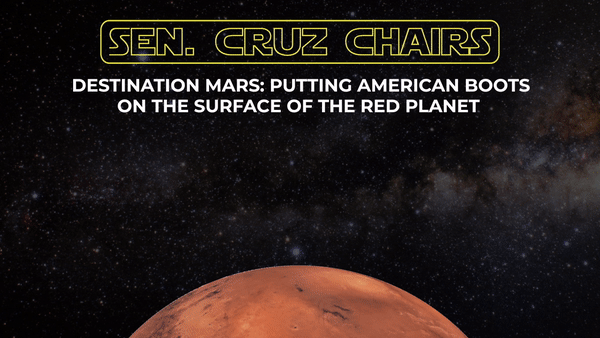Sen. Cruz Chairs Hearing Focused on America’s Future Exploration of Mars
‘Mars is the focal point of our national space program, and if American boots are the first to set foot on its surface, it will define a generation -- Generation Mars’
WASHINGTON, D.C. – U.S. Sen. Ted Cruz (R-Texas), chairman of the Senate Subcommittee on Space, Science, and Competitiveness, today chaired a hearing examining the future of America’s leadership in space, and explored issues regarding our work to land an American on the surface of Mars in the 2030s. There, he directed his line of questioning to expert witnesses on America’s space exploration priorities to further assert the United States’ competitiveness in the final frontier.
Sen. Cruz has been a long-time supporter of NASA’s efforts to land an American on the surface of Mars, and reiterated his belief that “The first foot that sets foot on Mars will be an American foot, and an American explorer. That’s leadership that I think this country needs and values. Restoring America’s leadership in space I think is incredibly important.” The hearing, titled “Destination Mars – Putting American Boots on the Surface of the Red Planet,” is the first in a series of hearings that will lead to the introduction of a new NASA authorization.
“That’s why we are gathered here today. To build upon the framework that was established in the NASA Transition Authorization Act of 2017,” Sen. Cruz said. “And to make progress in ensuring that our nation’s exploration priorities are being met so that we can push humans further than they’ve ever gone before. Somewhere in a classroom today in Texas, or Florida, or Massachusetts sits a child who may one day become the first American to reach the surface of the Red Planet. It’s our responsibility to ensure that we have a national space program that can help turn that dream into a reality.”
Watch Sen. Cruz’s opening statement in its entirety here. The full transcript of the senator’s opening statement is available below:
“On December 14, 1972, before returning home, Apollo Astronaut Gene Cernan took the last steps on the lunar surface and stated, ‘As I take man's last step from the surface, back home for some time to come, but we believe not too long into the future, I'd like to just say what I believe history will record: That America's challenge of today has forged man's destiny of tomorrow. And, as we leave the Moon at Taurus-Littrow, we leave as we came and, God willing, as we shall return: with peace and hope for all mankind.’
“These words are just as true today as they were in 1972. America’s challenge during the Apollo era has forged man’s destiny. That destiny I believe, is to put American boots on the surface of Mars. It has been more than four decades since Gene Cernan left the lunar surface. NASA is once again looking to return to the Moon in the 2020’s, and will use it in turn as a stepping-stone to reach Mars in the 2030’s.
“Even though we’ve been to the Moon before, our return will not be easy, as a generation of engineers and scientists at NASA have since left the workforce. While the Moon will provide a great testing ground in preparation for a journey to Mars, we must remain vigilant, and ensure that we limit costly delays that could push a crewed Mars mission in the 2030’s out of reach.
“Let me be clear- Mars is today the focal point of our national space program, and if American boots are to be the first to set foot on its surface, it will define a new generation -- Generation Mars.
“In preparation of a crewed mission to Mars, NASA has been sending scientific robotic missions to the fourth planet in our solar system for the past four decades. Yet, we still have more to discover.
“Last month, NASA’s Curiosity rover discovered organic compounds which may be a sign that there was once life on Mars. While the discovery of organic compounds leaves scientists with more and more questions, it also leads us to believe that we are on the right track.
“And just today, the journal Science published a report on radar evidence of subglacial liquid water on Mars. Using radar profiles collected from a satellite between May 2012 and December 2015, scientists have found evidence of a 12-mile-wide reservoir of briny water beneath the South Polar Layered Deposits. This and other exciting discoveries deserve to be built upon, explored, and studied to their full potential.
“That’s why we are gathered here today. To build upon the framework that was established in the NASA Transition Authorization Act of 2017, and to make progress in ensuring that our nation’s exploration priorities are being met so that we can push humans further than they’ve ever gone before.
“Somewhere in a classroom today in Texas, or Florida, or Massachusetts sits a child who may one day become the first American to reach the surface of the Red Planet. It’s our responsibility to ensure that we have a national space program that can help turn that dream into a reality.”
Watch the full hearing here.

###
